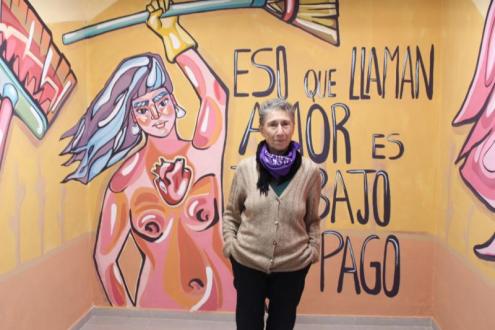By Asanda Benya
The Journal of Peasant Studies
February 2021
The title of Federici’s book ‘Re-enchanting the World’ is a wordplay on a lecture given by Max Weber in 1917 entitled ‘Science as a Vocation’ where Weber talked about the disenchantmentof the world, by which he meant the disappearance of the‘religious and sacred from the world’. Drawing on more than three decades of scholarship, Federici take us on a radical journey, as she has with all her other books, this time towards re-enchantment. Re-enchanting the world according to Federici is the renewal and rebuilding of our lives around commoning ideals and stronger and healthier relations, reconnecting with every living being, including land, mountains and rivers. It is about reclaiming and recovering what we have lost as a result of the deepening crisis of capitalism. The‘ground zero’ of this re-enchantment is the household and reproductive activities performed by women.
The first part of book unpacks the‘new’ enclosures in great detail and argues that these enclosures are the backbone to capitalist globalization. From an avowedly feminist Marxist perspective, she illustrates continuities between the old and new enclosures and their destructive tendencies, which includes depriving people of their rights to and control over their means of subsistence. The logic of the new enclosures has continuities with past trends of capitalist development and colonization, even though the social context of violence, destruction and dispossession differs significantly. Federici argues that globalization is a continuation of the process of primitive accumulation, one facilitated by programmes spearheaded by the West and institutions such as the International Monetary Fund (IMF) and the World Bank. The IMF’s Structural Adjustment Programmes and World Bank’s ‘economic recovery’ and ‘development’ plans targeted specific countries in the Global South, defunded public programmes, dis-mantled the welfare state in the Americas and smashed China’s ‘iron rice bowl’ during their transition to capitalism. This has led to the deepening debt crisis characterized by the global spread of microcredit and microfinance from Bangladesh to Bolivia, paralleling student loans and mortgages in the US.
Federici gives a brief historical overview of debt, from the 6th century BC until the present.The current debt is productive for capital; opening up new markets, new-enclosures and manufacturing new vulnerabilities that capitalism has exploited indiscreetly. Its corollary misery,shame, isolation and intensifying domination particularly for women, workers and the commoners who are the‘wretched of the earth’. She empirically demonstrates a clear relationship between the programmes of the IMF and World Bank, and the debt crisis crippling the world.The debt crisis has in fact facilitated the recolonization of Africa,‘with the West replacing the colonial powers in their imperial role’(41). Debt has been used by colonialists to recover what they lost during the anticolonial struggles, with the help of the political elites and ruling class–who willingly passed down to the citizenry‘the most murderous austerity policies’(42). Under-standing the devastating and destructive‘cumulative impact of these policies’ and programmes is key to making sense of the multiple capitalist crises.
What makes Federici’s take on the new enclosures fascinating is not only her historical account and links she makes between the new enclosures and primitive accumulation, buther notion of ‘glocality’. She seamlessly moves across the globe, drawing from her experiences with market women in Nigeria or activists in Latin America or movements in the United States.
Federici draws heavily on scholarship produced in the global South in outlining the magnitudeof the capitalist crisis and how people are resisting it through the commons.
She concludes the section by focusing on how the new enclosures–which threaten our commons–have generated resistance leading to the mobilisation and rise of new movements such as the anti-debt and‘liberation from debt’ movements. In Africa these movements have also pressured and forced the IMF and World Bank to cancel part of the debt incurred by countries that implemented SAPs. Their long-term success, however, depends on their ability to not only object but reconstruct the commons destroyed by capitalism.
The second part of the book is devoted to the commons. She critically unpacks the commons and maps their multiple iterations, threats and possibilities in different parts of the world. Federici revisits what she calls ‘radical experiments’ with commoning; these are commons against and beyond capitalism. She distinguishes the commons from the public(which re-inscribes and legitimizes the private), from‘gated commons’, from enclosures such as the university, from commons with ‘uncommon’ aims, and the commodity producing commons which are tightly linked to (international) markets and reproduce the capitalist logic of accumulation. Federici argues that the latter social formations are not real commons but‘safety valves’ through which capitalism diffuses its permanent crisis, what she considers to be an everyday crisis of production and reproduction, a deep crisis which permeates all aspects of life, exhausting all resources, causing not only insecurity but alienation, fear and depression.
Federici introduces radical or anti-capitalist commons that work against the crisis ridden capitalist logic and value context-specific ways of knowing, being, doing and local ‘technologies’. These commons are based not on material wealth, but social relations that are a product of communal struggle. In other words, they are not‘natural’but built in struggle, in attempts to organize our collective existence, they are what she calls a‘political frame of thinking about alternatives to capitalism’(87). These are not some experiments by hippies in the middle of the forest, but a commoning of social and property relations including social reproduction, which is a critical aspect of our survival and resistance. These commons work against the logic of capitalism, creating more cooperative forms of care work, restructuring production and reproduction towards egalitarian social relations.
While there are striking parallels between Federici’s commoning and communalism, she warns that the two should not be confused with each other because when considered from a feminist and ecological standpoint, commoning is a departure from communalism. She argues that commoning goes beyond the act of sharing and solidarity bonds produced, it is political.
Women are key actors in Federici’s past, present and future commons, constructing and defending the commons, blockading mining operations, and revolting against privatization of water and rivers and appropriation of land. The centrality of women is attributed to their involvement in reproductive work and land struggles in Africa and Latin America, engenderingan appreciation of our resources as the finite, crucial for understanding‘the re-enchantment of the world’(195). While one appreciates the role Federici ascribes to women, there is also a niggling discomfort about their centrality. For one it might possibly reinforce the idea that house-work is primarily women’s work. Women’s bodies were, after all, thefirst enclosures, the con-trolled and disciplined site for capitalist accumulation. It is their social reproduction work thathas also rendered them vulnerable in the face of capitalist threats. Yet Federici dismisses this tension of having women at, and as, the centre. Instead she is suggesting that the insistence on women playing a central role is in fact a way of reclaiming and refusing the erasure of their‘collective experiences, the knowledge and the struggles that women have accumulated concerning reproductive work, whose history has been an essential part of our resistance to capitalism’(113). While that might be so, it remains unclear how their centrality in the emancipatory commons will not essentialize and homogenize women and will not reinforce the idea that social reproduction is primarily women’s work.
The book also seems to be straddling a ‘productive’ tension between the ‘local’ and ‘community’ in Federici’s conception of the commons. What is‘local’, what are the boundaries of what constitutes the local? Who qualifies as local? Equally, what is a community? How should we conceive of what constitutes a community, is it struggle based or marked by aradius from point A to B? Federici does not tell us how she thinks of these. On one hand a community is depicted as a locally‘grounded’ collective but on another, it is global, especially when referring to techno commons who operate at different parts of the globe. The emphasis on the local is prominent when Federici talks about the significance of local actors, local technologies, local relevance and local context. It seems to me then that the commons require a ‘community ’not necessarily a local one. Federici’s position is that we do not or cannot have a‘global community’ and thus cannot speak of‘global commons’, what she sees as a misleading notion often used by the IMF and World Bank to carve space for their destructive programmes.What about commoners whose‘work’renders them effective only if global in scale–in a geographical sense–makes them non-commons? What about globality makes commoning impossible, or what about commoning makes it so inconceivable or not radical enough when it is on a global scale, especially considering the fact that capitalism is global, its effects and the ecological crisis felt across borders? How do we common on the micro-level and only cooperate on a global scale and still defeat capitalism? Granted there are power relations between the so-called global North and South that would make commoning across those borders challenging, but what of global South, unequal as it is? Why does location, when it comes to commoning, seem to trump political commitments? The global‘cooperation’ that Federici suggests instead of global commons is also riddled with its own challenges and power dynamics, which are not addressed.
The question of the local and community have implications for the‘we’at the heart of the commons and commoning. It also helps us think through the question of difference in the commons, the differences that contribute to the internal struggles within the commons or the differences that contribute to the cooptation of some commons by capital.
While Federici touches on race and colonialism and makes radical calls for reparations in the Americas if they are to build the commons, race (and racialism) remains on the margins and is not treated as a constitutive feature of the global capitalist regime (Robinson1983).In Federici’s framework race is not considered a legitimate lens through which to read the new enclosures, crises, destruction and dispossession. This matters when considering whose land has been appropriated, water wells poisoned, and which regions have been devastated and are suffering environmental disasters and the ways in which the capitalist crisis unfolds unevenly.We are not equally affected; the global South, the darker nations, continue to suffer disproportionately compared to the global North. Even within the global North, the capitalist devastation follows a spatial racial logic that mirrors the global South. Within the global South,the settler community is not affected to the same degree as the indigenous.
Federici acknowledges there are many unresolved issues with the commons, one being the role of the state in our commoning and connecting struggles within the commons. What makes the commons so captivating is that they help us imagine radical alternatives to capitalism. Moreover, the commons reject its logics that have a tight grip on our subjectivities and pursue freedom that does not come at a cost to others (such as women who have been doing care work), or create hierarchies of masters and servants, nor rely on new forms of colonization or enclosures elsewhere, nor the‘production of death for others’(109). The commons open up‘spaces of hope’(Harvey2000) and spaces of resistance, where we can creatively live our lives, reimagine production and reproduction in a more cooperative way and do away with‘the separation between the personal and the political and between political activism and the reproduction of everyday life’(112). As she argues,‘if commoning has any meaning, it must be the production of ourselves as common subjects’(110).References Harvey, D.2000.Spaces of Hope. Edinburgh: Edinburg University Press.Robinson, C. J.1983.Black Marxism The Making of the Black Radical Tradition. London: Zed Press.








